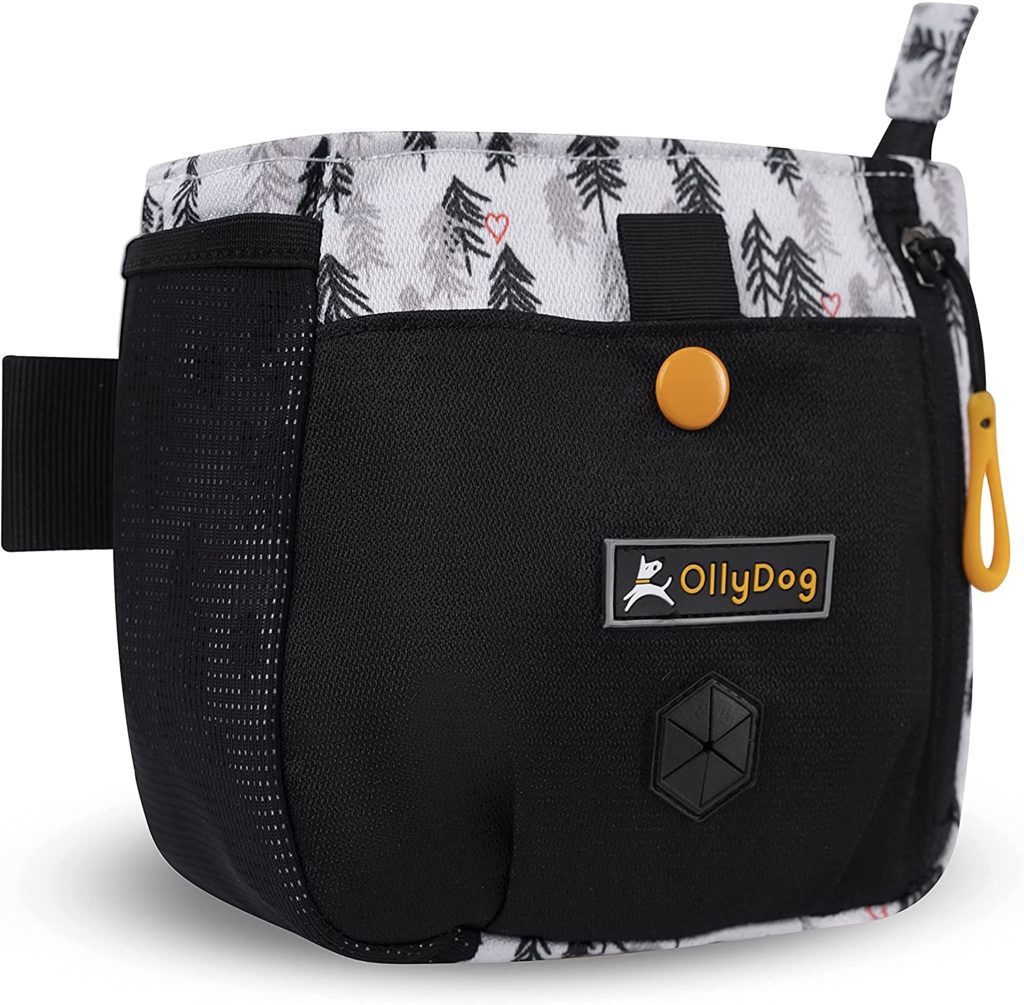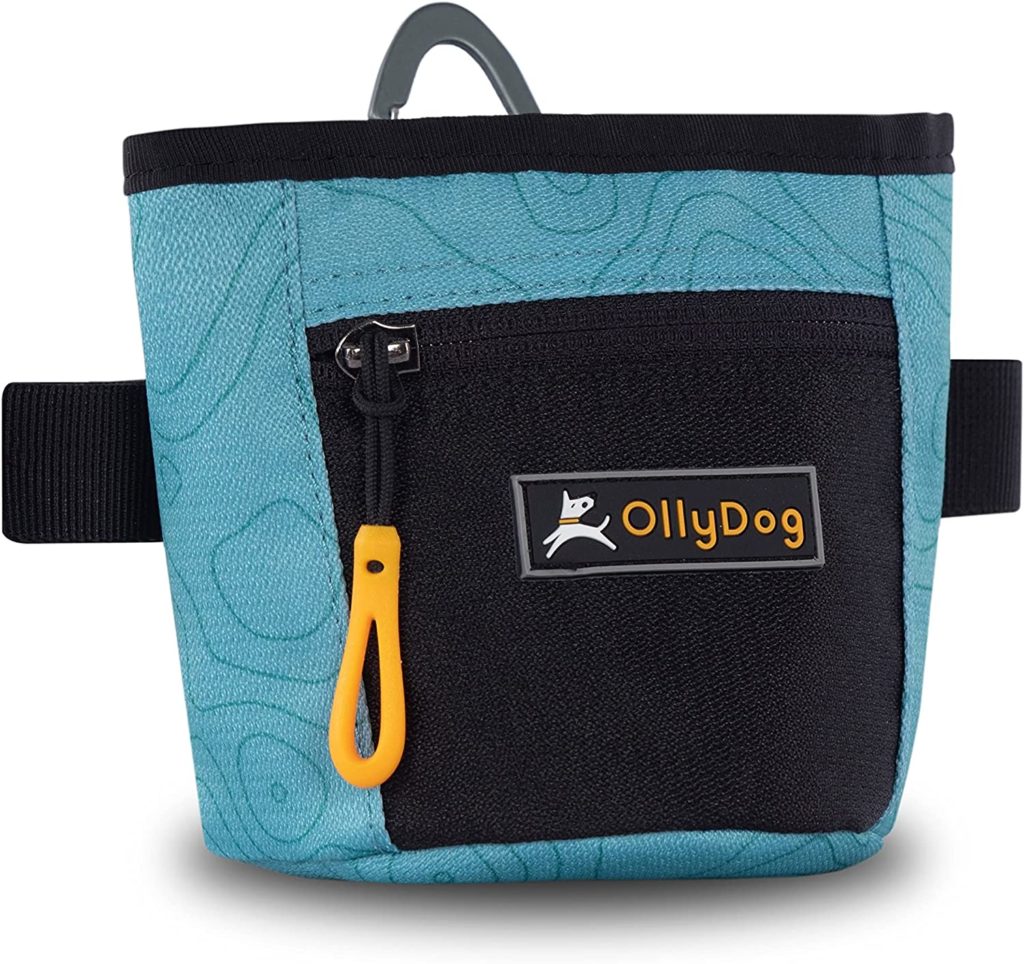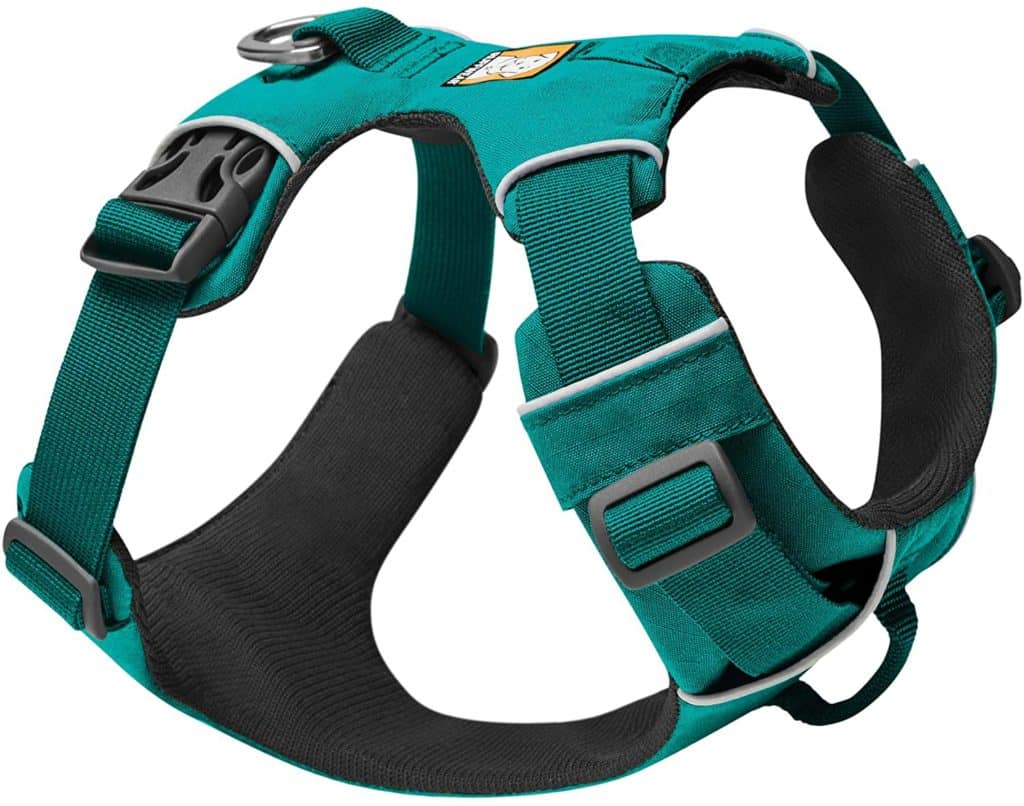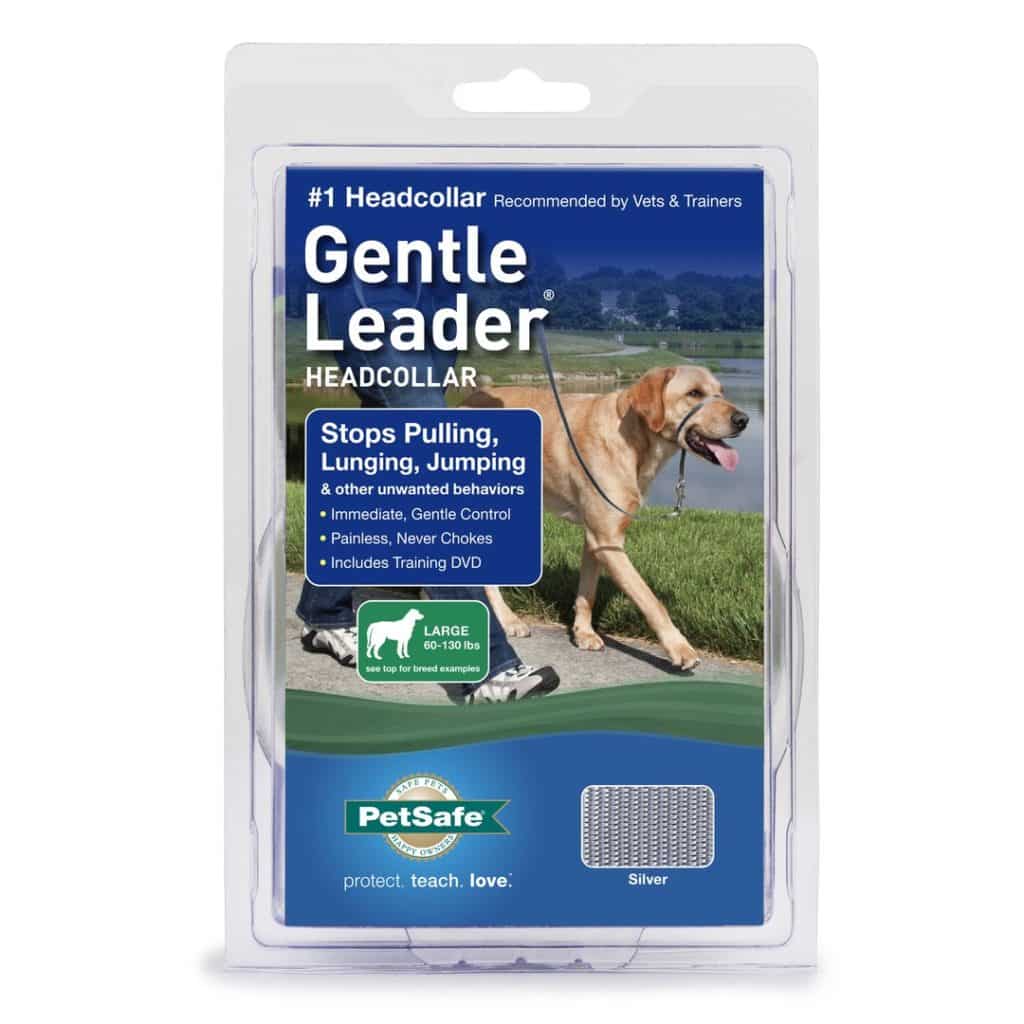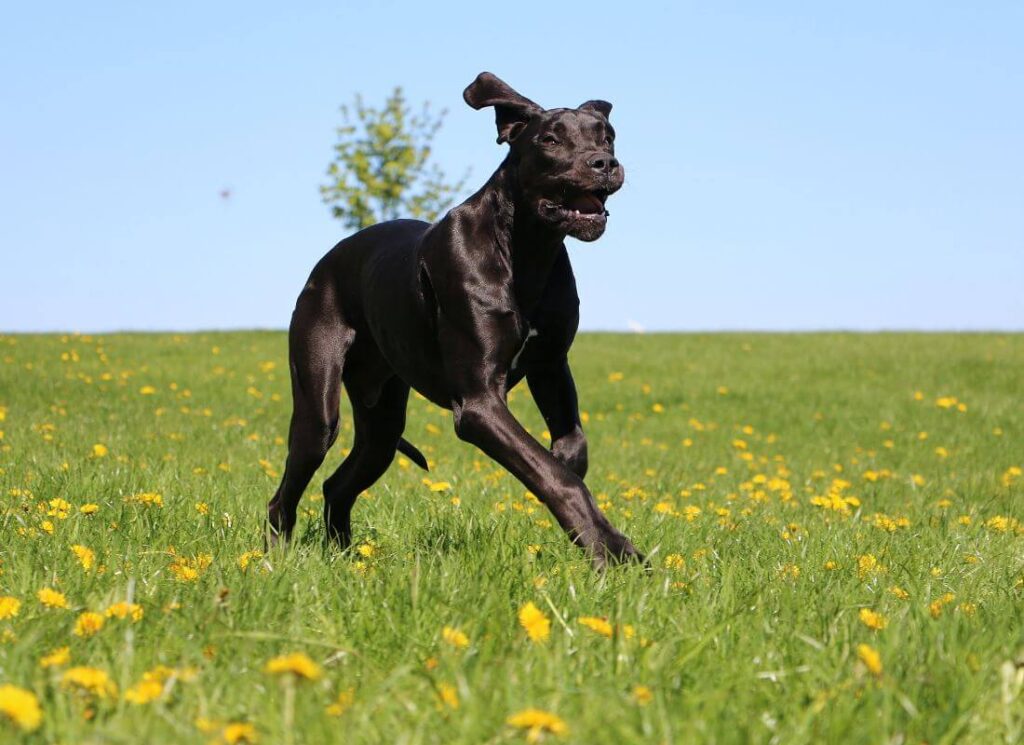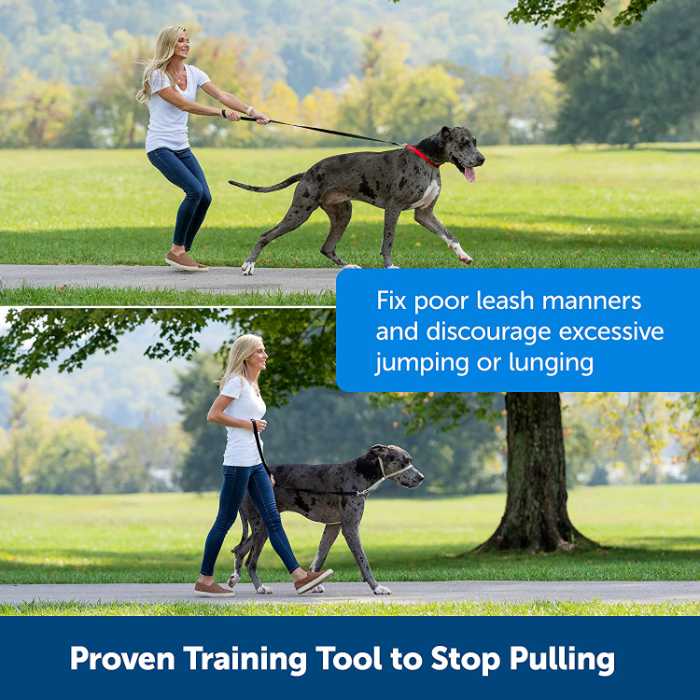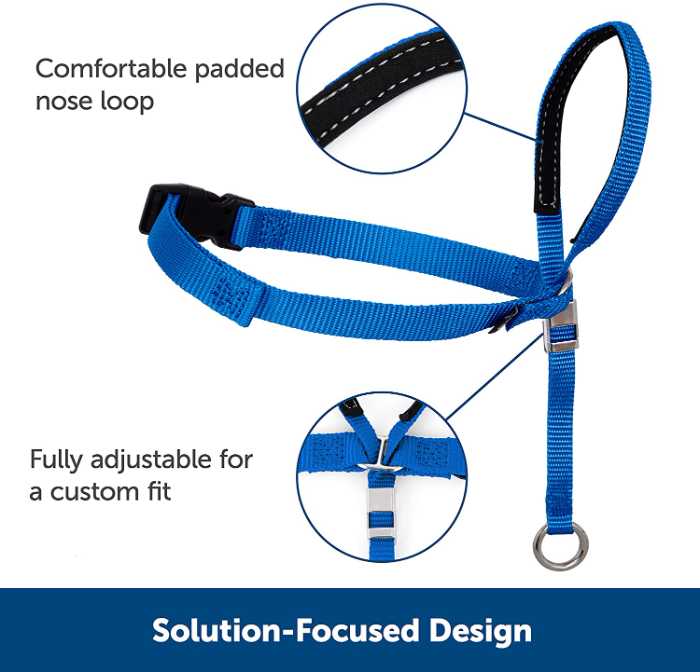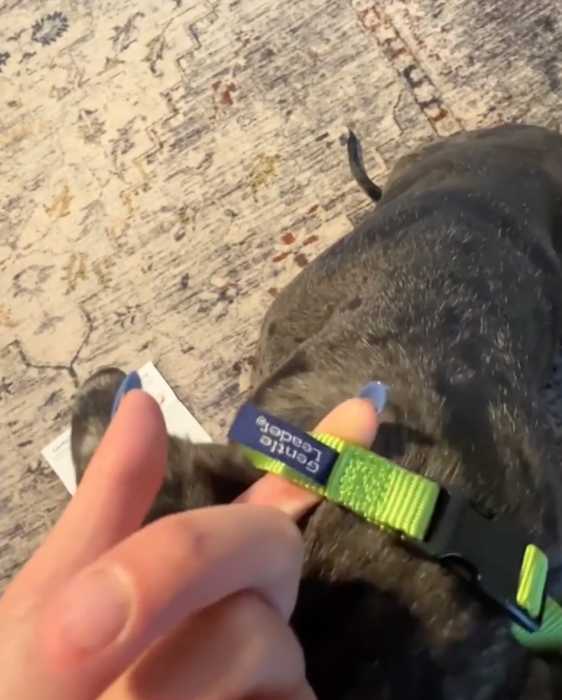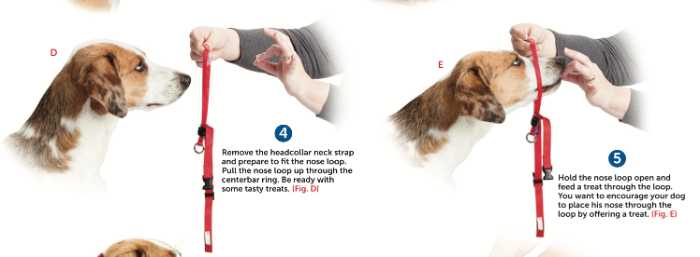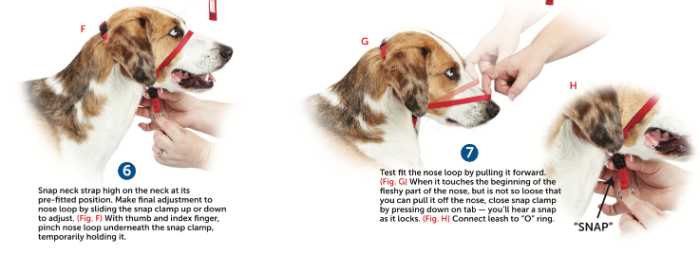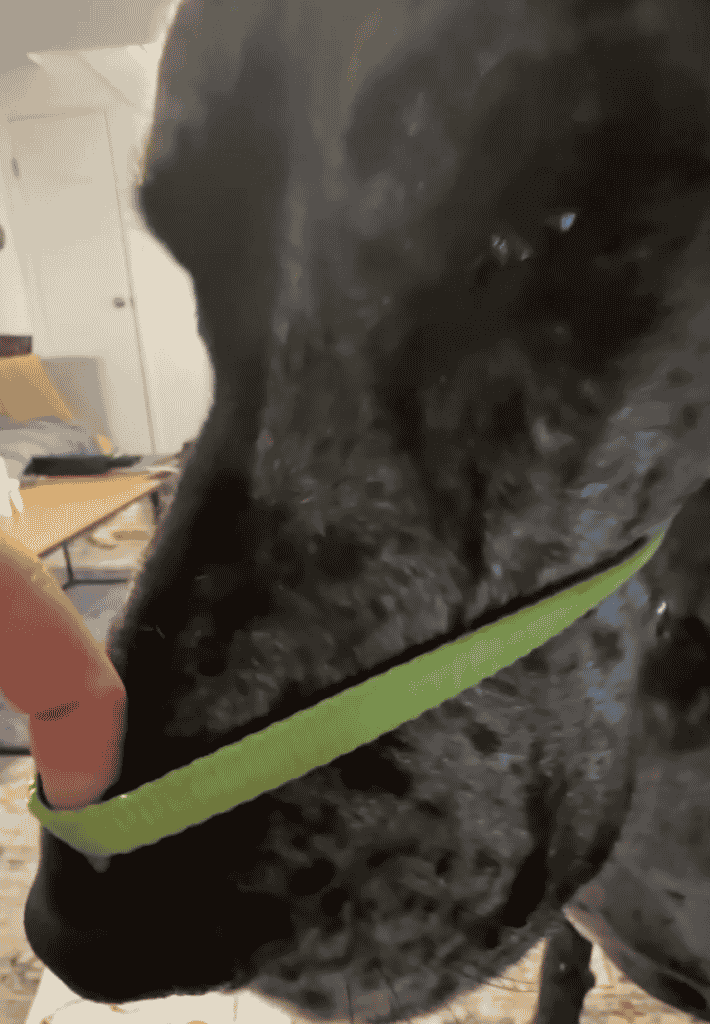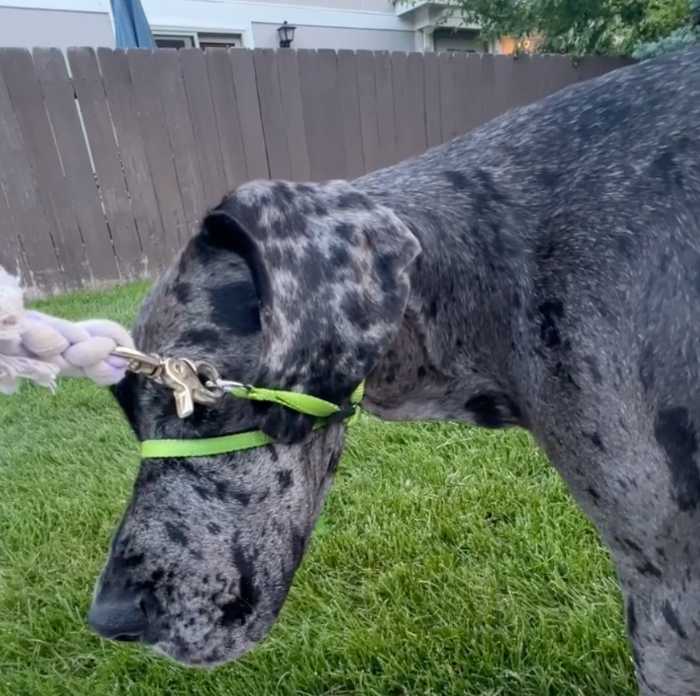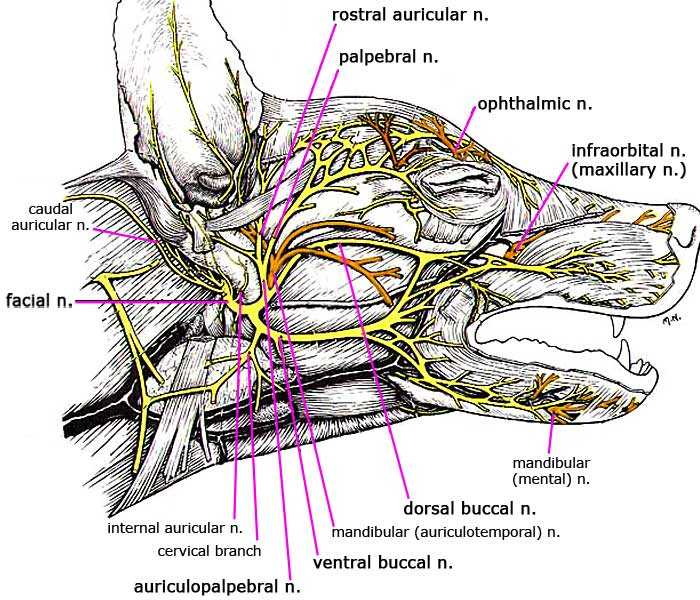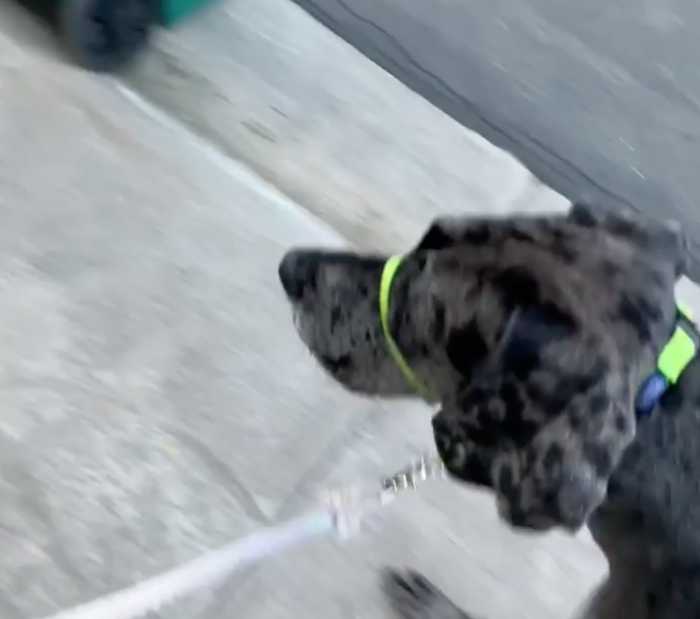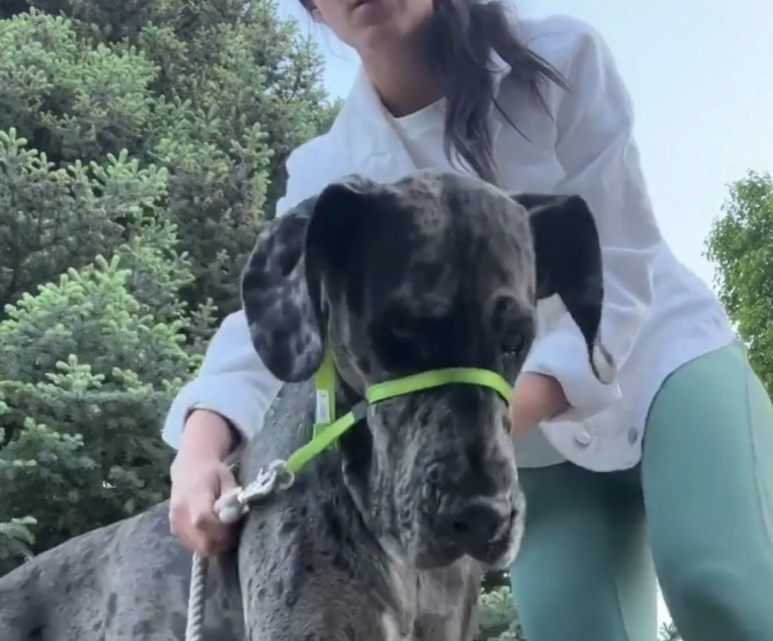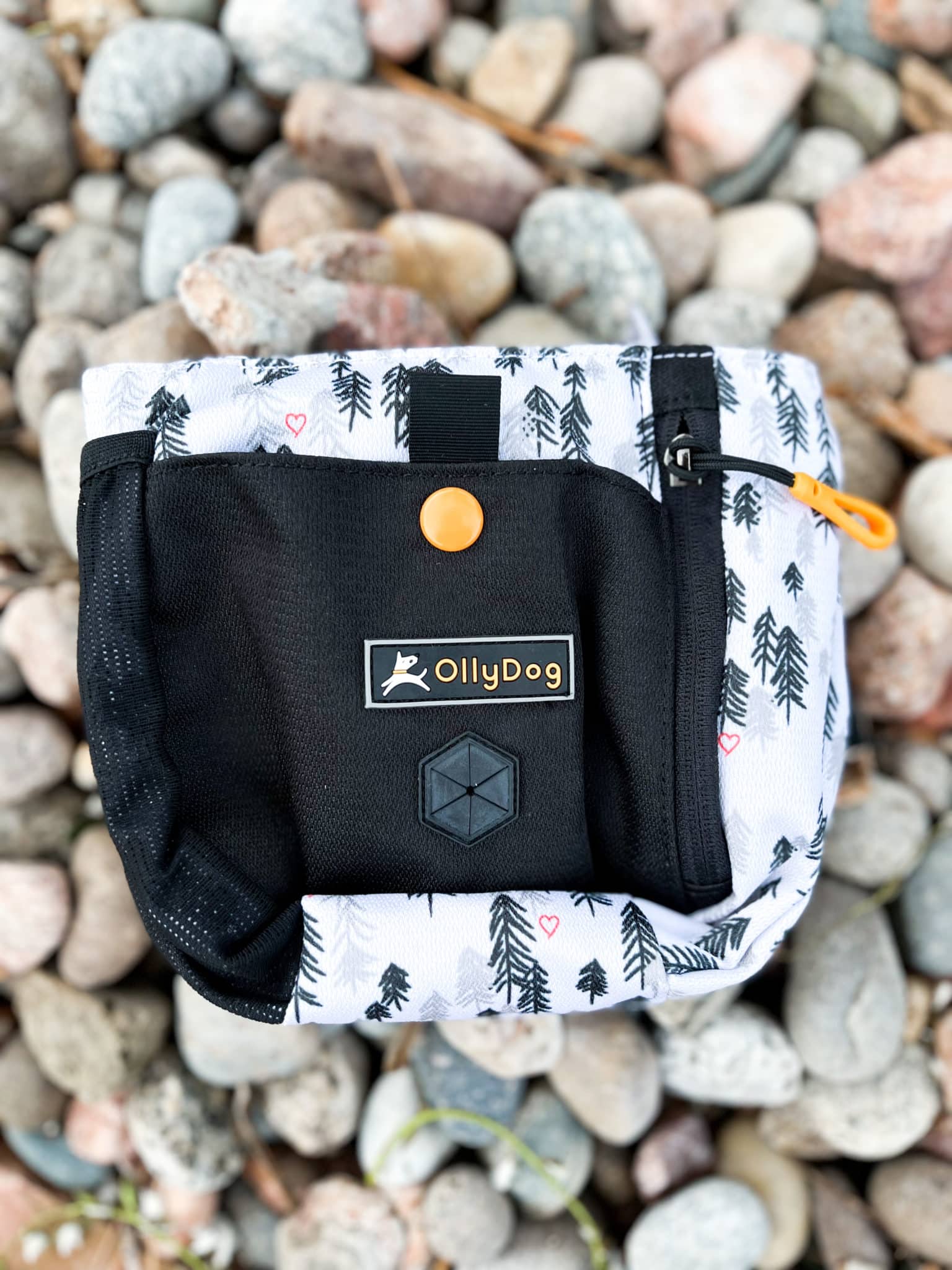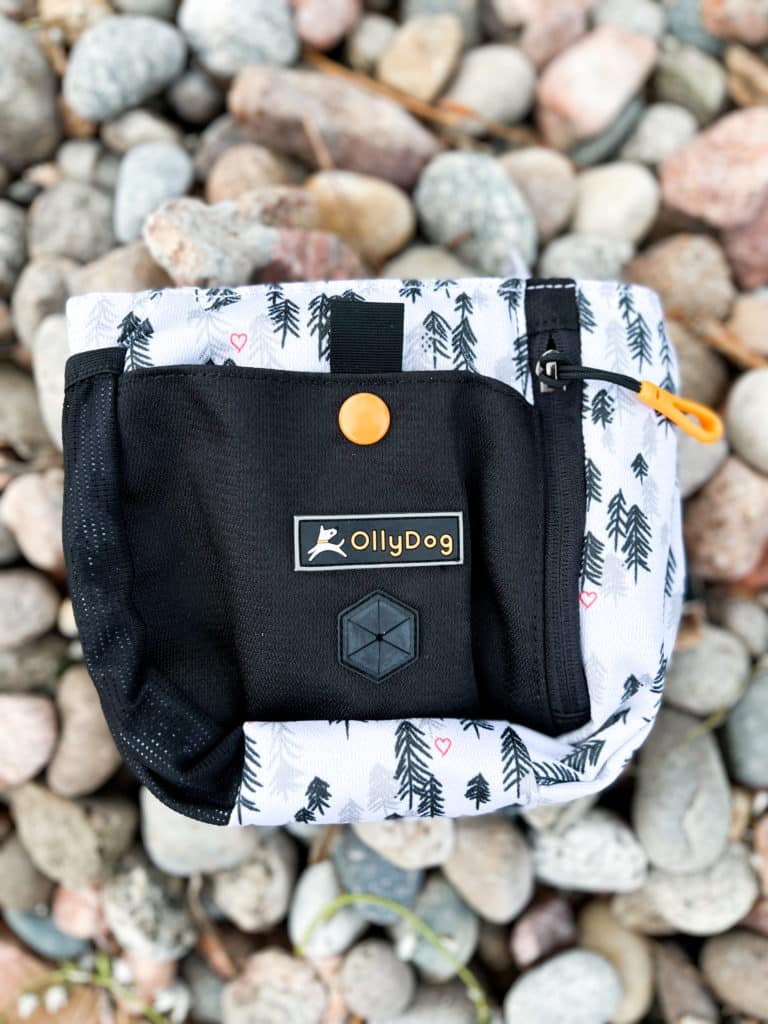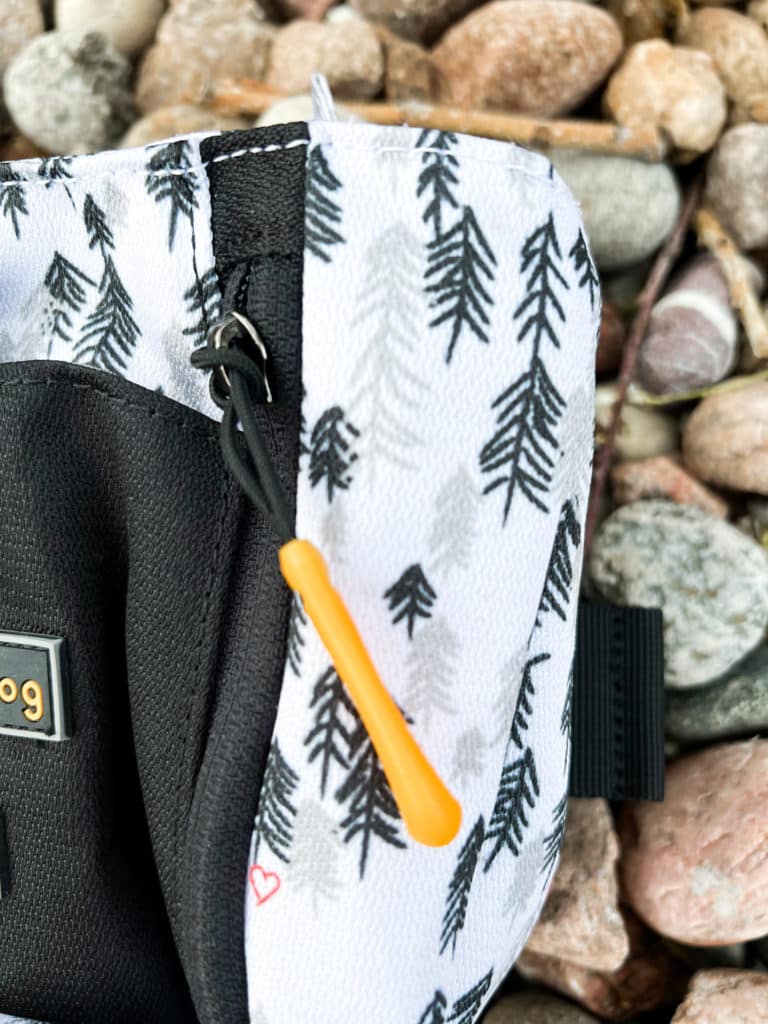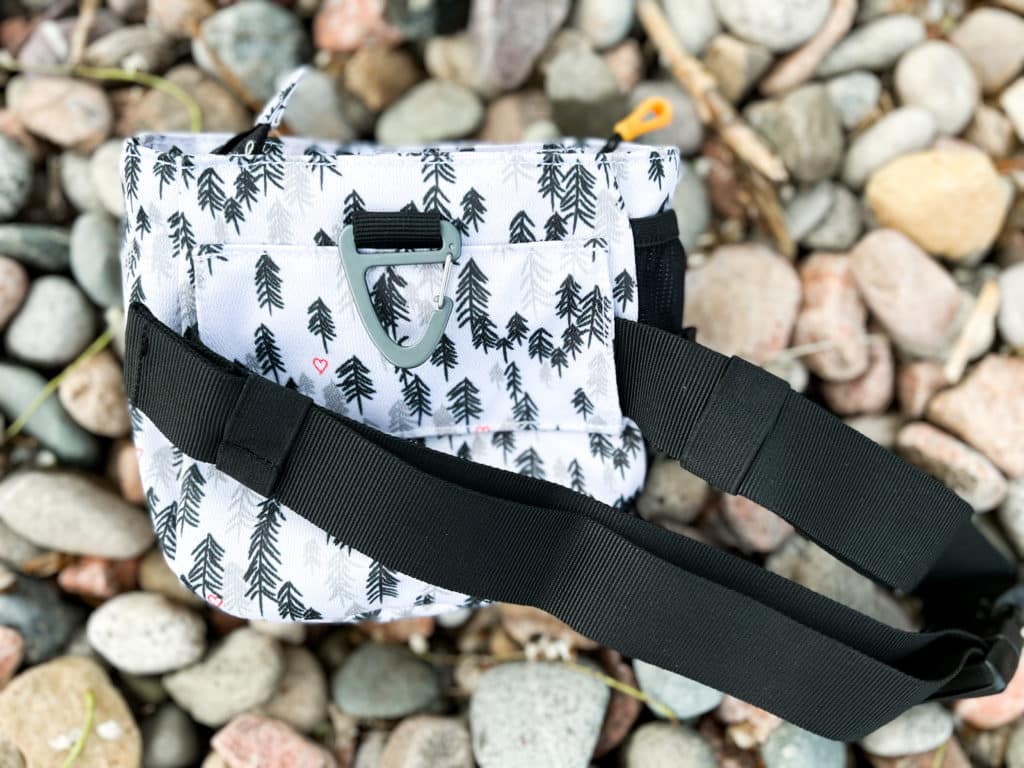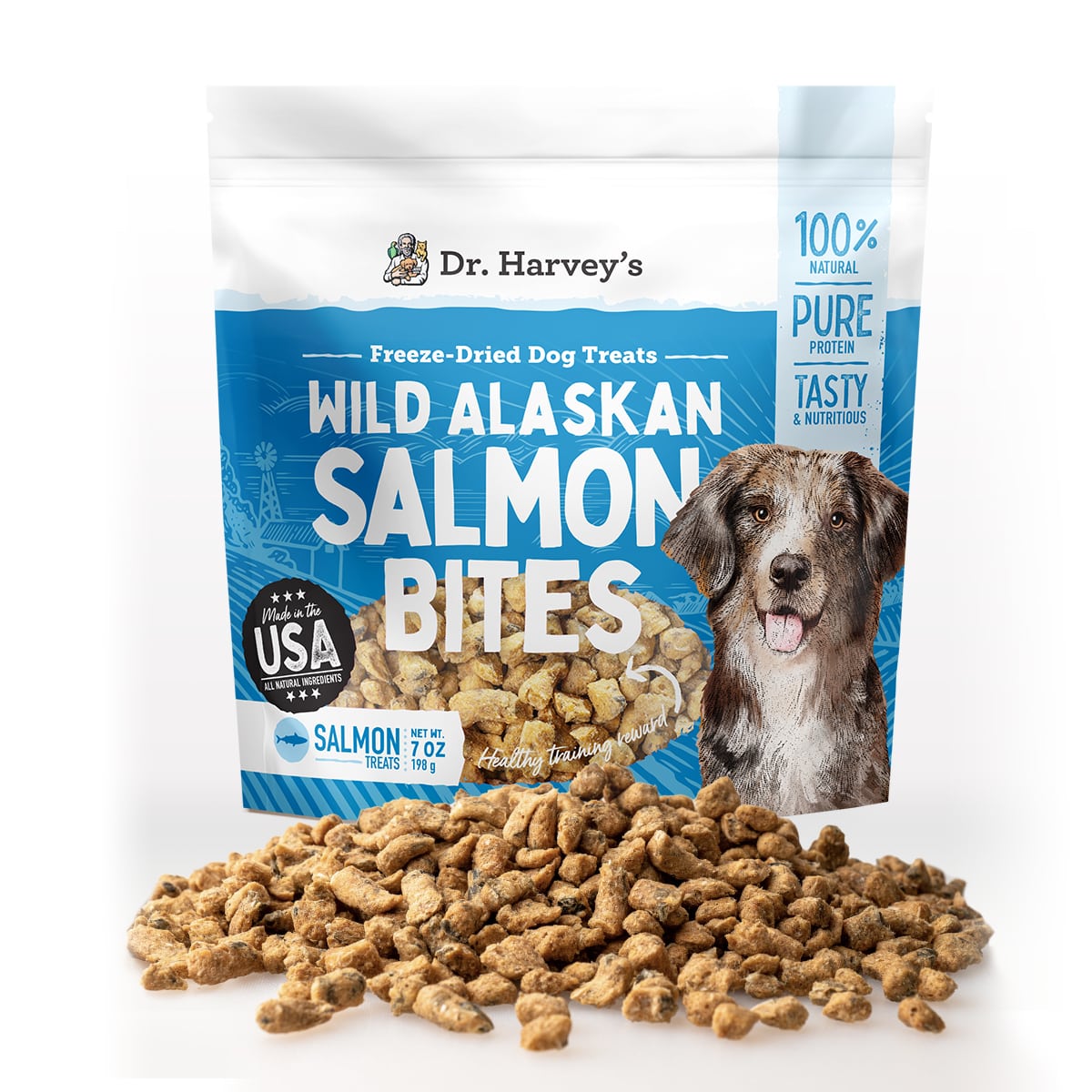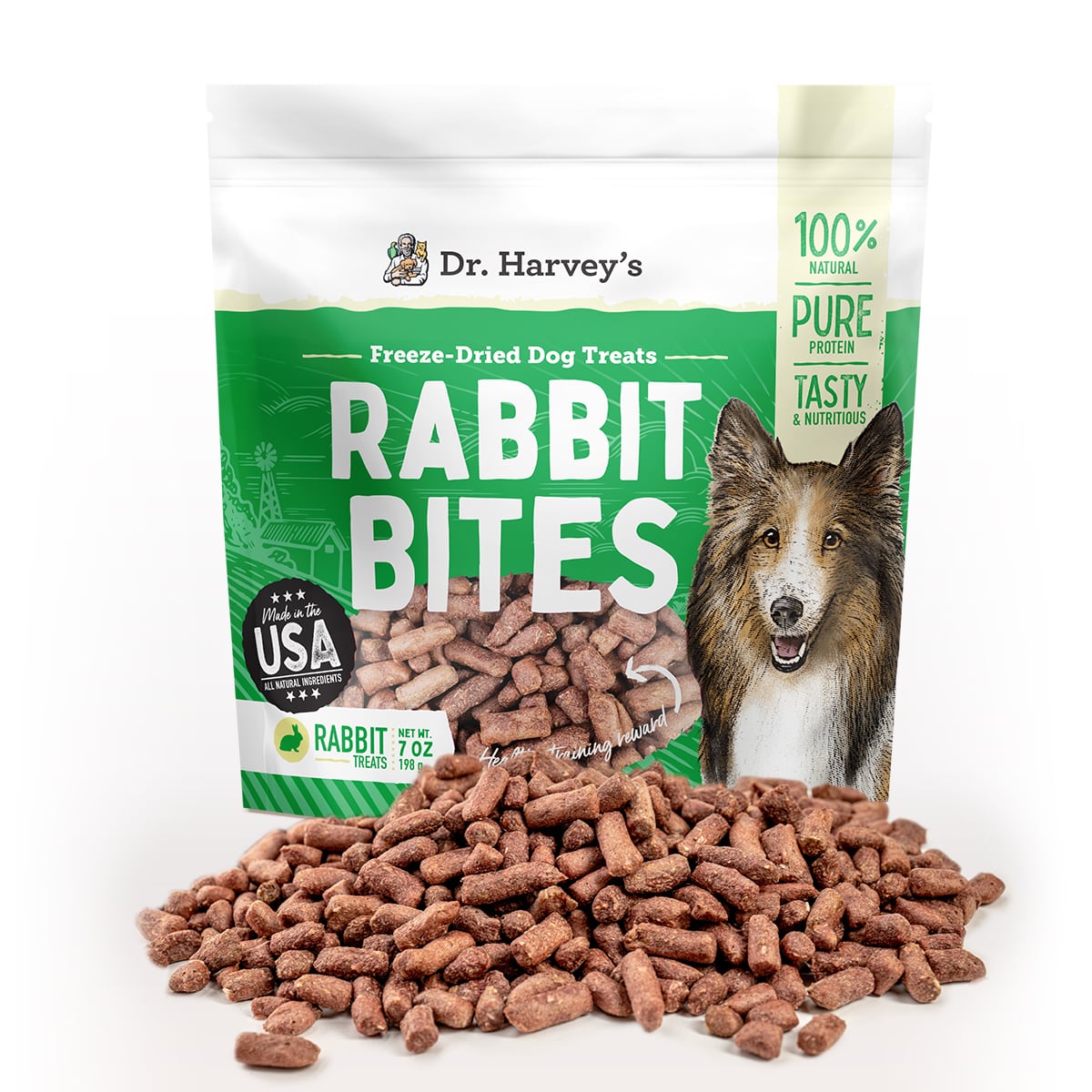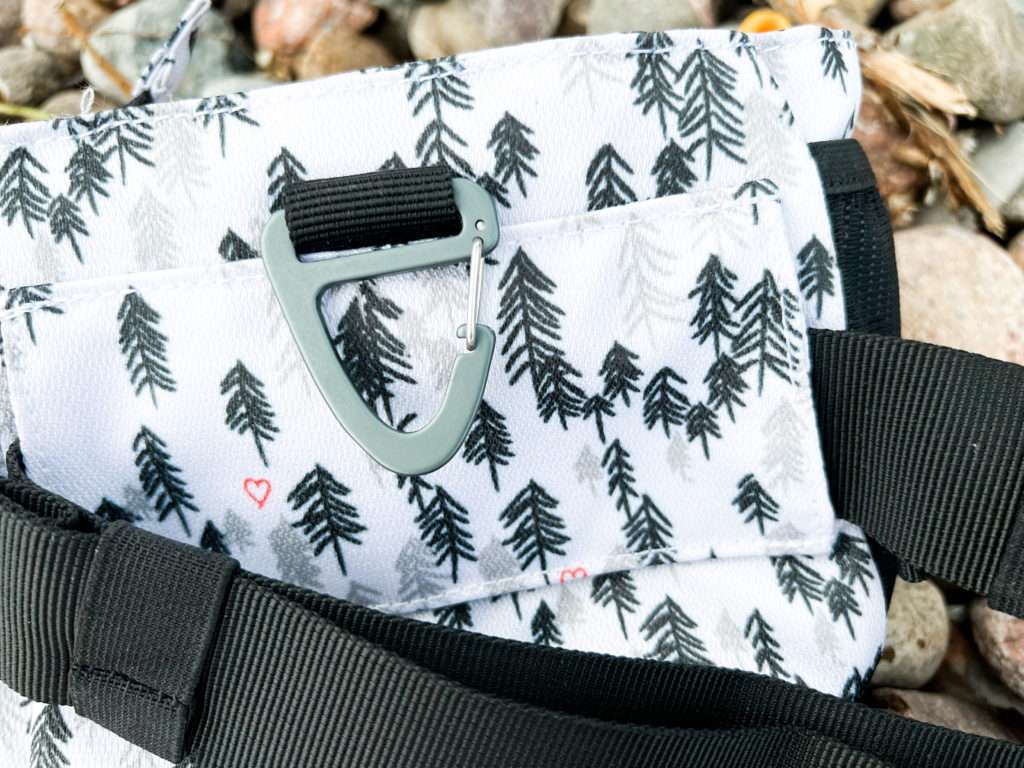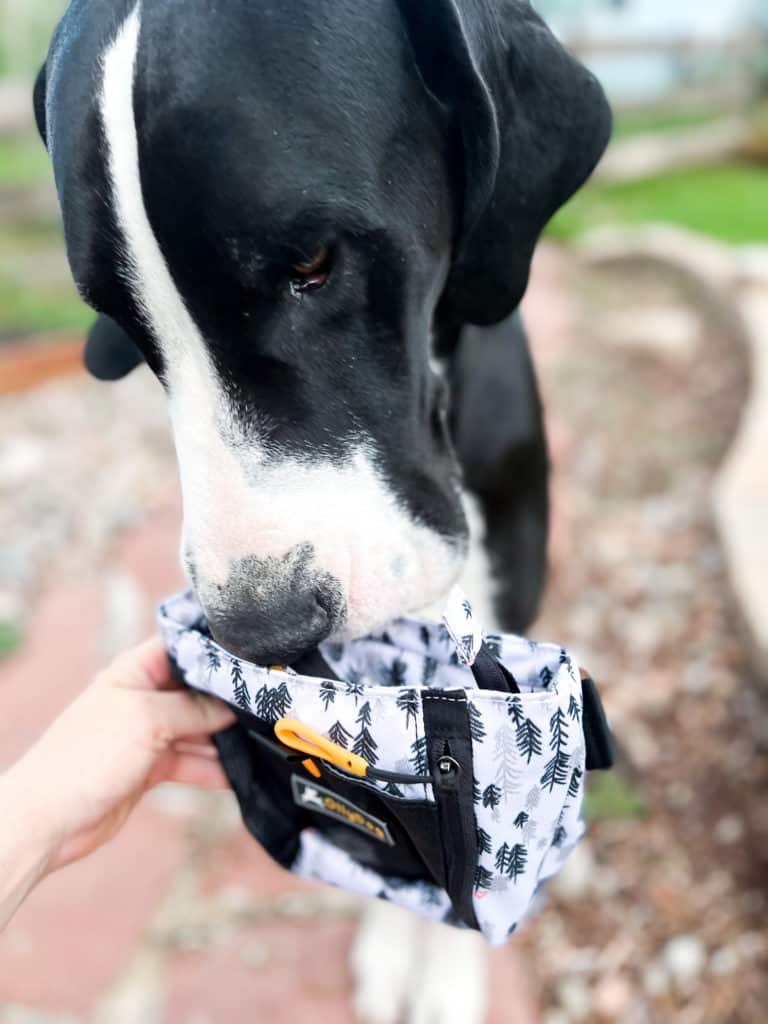There are a lot of different options available when it comes to choosing a dog collar. Today we are comparing the Gentle Leader vs. Prong Collar, so you can make an informed decision for your pet!
Two of the most popular tools to reduce pulling and lunging are the Gentle Leader (also known as “Halti” or “Head Collar”, and the prong collar.
Both have their pros and cons, so which one is right for your dog? In this blog post, we will compare the two collars and help you decide which one is best for your pup!
What is a Gentle Leader?
A Gentle Leader is a type of head halter or harness that your dog wears on their face. It is made of nylon webbing and will typically wrap around the dog’s muzzle and over the back of the head.
The leash is then typically attached at the bottom of the muzzle at the dog’s throat, or from the back of the head. Some head collars have a ‘martingale action’ loop that will cause the straps to further tighten if the dog pulls.
The design of the collar makes it very uncomfortable for the dog to pull, run, sniff the ground, or lunge and allows you to direct your dog’s head back towards you.
Common brands include the Halti and the Gentle Leader. Many people with large and giant breed dogs rely on this training tool, citing an immediate difference in their dog’s pulling behavior and leash manners.
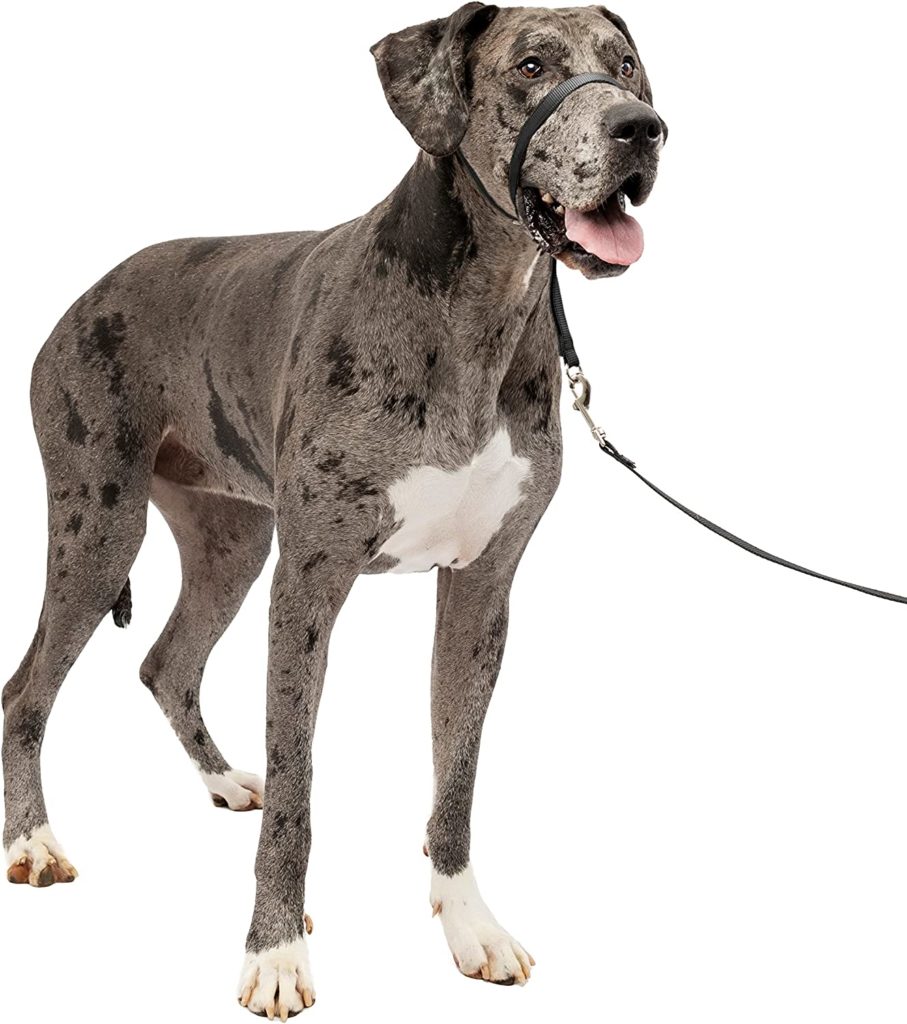
Is the Gentle Leader actually gentle?
The short answer is…no! The Gentle Leader (or any similar head halter type training device) is actually very aversive, frustrating, and annoying to most dogs.
This is why they work so quickly!
A training tool like this will require a lot of conditioning to encourage the dog to accept it. Even following that, we see many dogs show negative body language while wearing them.
The signs of frustration, anxiety, and discomfort associated with the Gentle Leader include:
- Rolling on the ground
- Rubbing their face on your pants, the carpet or grass
- Pawing at their face
- Shaking their head
- Running away from it when you try to put it on
- Resisting and hiding their face when you try to put it on
- Scratching their face and eyes until they break the skin
- Whale eye (wide eyes)
- Pinned ears
- Hiding behind your legs
- Head down and hunched shoulders
- Becoming ‘hand shy’ (shying their head away from petting or facial handling)
While it’s important for your dog to learn how to walk nicely on a leash, we’re not convinced that the ‘quick fix’ of a head collar is the most humane choice.
Positive training sessions using just a flat collar in a low distraction area are a great way to start training your dog on how you want them to behave on a leash.
This is especially true for puppies and young dogs who have not yet developed a preference for lunging and pulling. If you are struggling with your dog’s pulling, we recommend seeking out the help of a highly qualified dog trainer in your area.
Are Head Collars a Positive Tool?
The short answer is again, no. Head collars are a surprisingly aversive tool that should only be used as a last resort by experienced dog trainers, or for highly-trained service dogs where small communications are necessary while in public.
This type of dog training collar can cause a lot of physical and emotional damage to your pet dog, especially when implemented without a lot of conditioning and positive reinforcement training.
We honestly do not recommend head collars for any dog, despite their widespread popularity and ‘positive’ marketing.
‘Positive’ implies that the dog will enjoy wearing it and have a good experience being taught not to pull. When it comes to training tools, the head collar is one of the most aversive options available.
How to Teach a Great Dane to Walk on Leash
Is the Gentle Leader an Abusive Tool?
Things that are More Aversive Than an E Collar in Training
What is the difference between a Halti and a Gentle Leader?
There is very little difference between these two training tools. When it comes to head collars, there are several brands and models on the market.
The concept is the same, however, no matter how the webbing and the final fit are actually styled and implemented.
Many dogs do better in one brand than another; it depends on the shape of their face. A dog’s head is full of sensitive nerve endings and every dog is different!
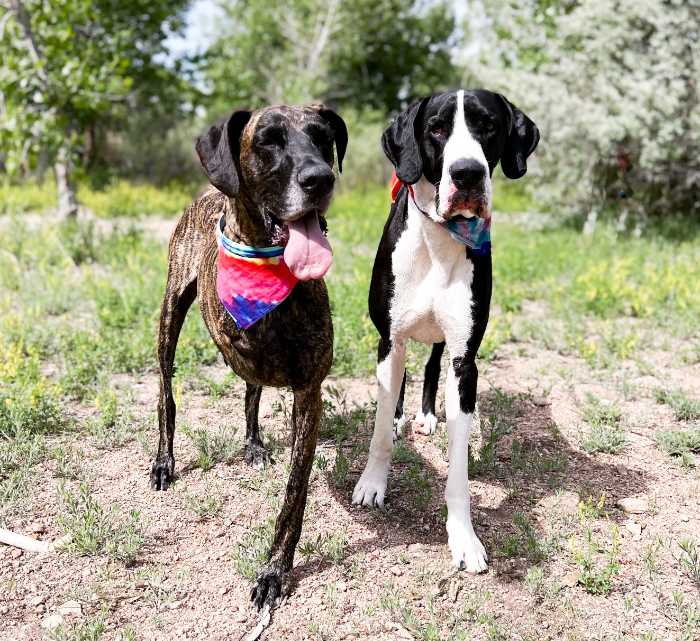
Can my Dog Wear a Gentle Leader if they have Wobblers?
Absolutely not.
As a matter of fact, a major reason we do not recommend head collars for large and giant breed dogs is that they can exacerbate existing or not yet known health conditions.
Wobblers disease is a condition that affects the vertebrae and spinal cord of the neck. Many dogs who have the disease show only mild symptoms for months or years before they are diagnosed. These symptoms are easy to miss and all the while, the damage is being done day by day.
Dogs with this disease should not wear any type of collar that regularly puts physical pressure on their head that can cause a whipping motion of the spine.
For dogs prone to wobblers disease (including Great Danes), the head collar should never be the tool of choice. We understand that this opinion may be upsetting to many people who are struggling with their dog’s leash walking.
In this blog, you’ll see a video of a dog wearing a head collar for the first time. You will notice how she shows stress signals and whips her head around when redirected via leash pressure.
The good news is, there are other dog training collars available that won’t hard your dog’s neck, alter the way they walk or physically harm them in any way. Read on!
(We highly recommend that you use lots of positive reinforcement when training your dog! Shop our favorite treat bags below).
What do I do if my Dog Hates the Head Collar?
Most dogs hate the Gentle Leader. It doesn’t matter what brand you choose, either.
Head collars are a foreign object to dogs, and they are not natural for them to wear.
This is why it is so important that you only use a head collar as a last resort, and only after you have tried other more positive methods of training first.
If your dog hates the head halter, we recommend taking it off and trying another method. Do not force your dog to wear this device, and tread cautiously with dog trainers who continue to promote this as a ‘friendly’ and ‘positive’ tool.
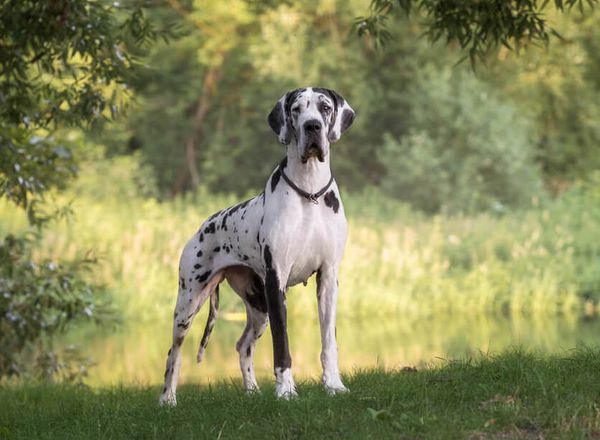
Why Shouldn’t You Use a Gentle Leader?
The main reason why we do not recommend the Gentle Leader is that it is a very aversive and potentially damaging tool.
Aversives are anything that causes your dog discomfort and stress, and should only be used as a last resort.
There are many other positive training methods available that do not require the use of aversives like this.
We understand that they have been marketed as a ‘positive’ device. This is, unfortunately, marketing that was designed to be misleading.
What about front-clip harnesses?
Many people are looking for a gentle and positive training tool to help their dog walk properly, politely, and gently on a leash. Enter the front clip harness!
There are several front clip no-pull harness options available, and some are better than others.
Traditional ‘no-pull’ harnesses such as the ‘Easy Walk’ (with a strap across the chest) work by applying pressure to the chest and forcing the dog to the side if they lunge into it. They suppress the dog’s ability to move naturally and restrict the forward movement of the shoulders, whether the dog is pulling or not!
If you do wish to use a no-pull harness, consider it a temporary training tool only. Choose a version with a Y-front, such as the Ruffwear Front Range or TrueLove harness instead, which are designed to be comfortable for the dog to wear and non-obstructive to their shoulders and gait.
Do NOT use an ‘Easy Walk’ or similar obstructive type device, which can be frustrating to your dog, painful to wear and potentially damaging. The following harnesses with a Y front are acceptable, however:
Make sure to use lots of positive reinforcement (ideally off-leash in a low distraction area to start) and ideally, consider a two-leash system where one leash is clipped to the front and one is clipped to the back.
We do recommend the use of an ergonomic front-clip harness system (see two choices above) before choosing a Gentle Leader, if you are not ready to look into prong collar training yet.
For some dogs, such as the American Eskimo Dog and other sled dogs, it will be very difficult to train in a properly fit ergonomic (non-obstructive) harness. These are dogs that were built and bred to pull!
Teaching dogs not to pull (when they are in a harness that allows them to do just that) is an exercise in frustration for many, many people.
Additionally, people who have large and giant breed dogs such as Great Danes may find that a harness gives the dog too much leverage and becomes dangerous to walk as a result.
Use common sense here and don’t be afraid of a prong collar or a gentle correction if it ultimately will give you and your dog more peaceful and enriching walks together.

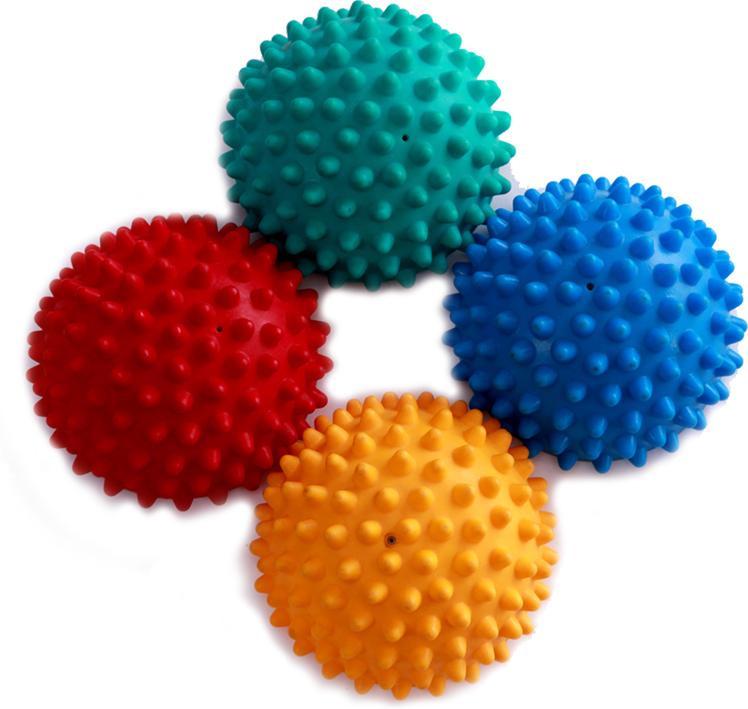
How do I Train my Dog with a Head Collar?
There is a time and a place for using a training tool like this! If you still believe in using a Gentle Leader or similar head harnesses for your dog, start slow and don’t look at it like a ‘quick fix’.
The conditioning and training process will be much easier on you and your dog if you start in a low-distraction environment, such as your backyard.
Remember that your dogs head has thousands of nerve endings, and your dog may find the nylon webbing to be uncomfortable to wear. Be patient if you want your dog to have better leash walking skills.
Make sure that your dog is very well-versed in basic obedience commands such as ‘sit’, ‘stay’, and ‘come’ before you attempt to put a Gentle Leader on them.
It is also helpful if they have a good foundation of the basic heel position, which is easy to teach using positive reinforcement.
Use small, high-value treats and introduce the collar to your dog.
Gently put the loop over your dog’s nose, say ‘YES’, offer a treat then slide it off again. Repeat this process until your dog willingly offers its nose for the loop on the collar.
Once your dog is comfortable with the Gentle Leader or head collar nose loop, you can put it on them, clip it closed, treat, and then immediately remove it. Practice this several times until your dog has a positive association with the collar.
For some dogs, this conditioning process may take weeks. Many dogs will continue to appear distressed while wearing a ‘Gentle Leader’ despite the conditioning process; you know your dog best!
Do this a few times before you actually take them for a walk. When you are ready to walk, make sure that you have treats handy and keep your voice calm and cheerful.
Start with short walks in low-distraction area. Discourage your dog from pawing at the collar or rubbing their face on your pants.
Be careful that you never deliver a harsh leash pop through the Gentle Leader. Avoid any kind of correction or movement that will cause your dog to whip their head around.
Additionally, we absolutely do not recommend the Gentle Leader training collar (or similar head halters) for dogs that struggle with extreme lunging, jumping and reactivity.
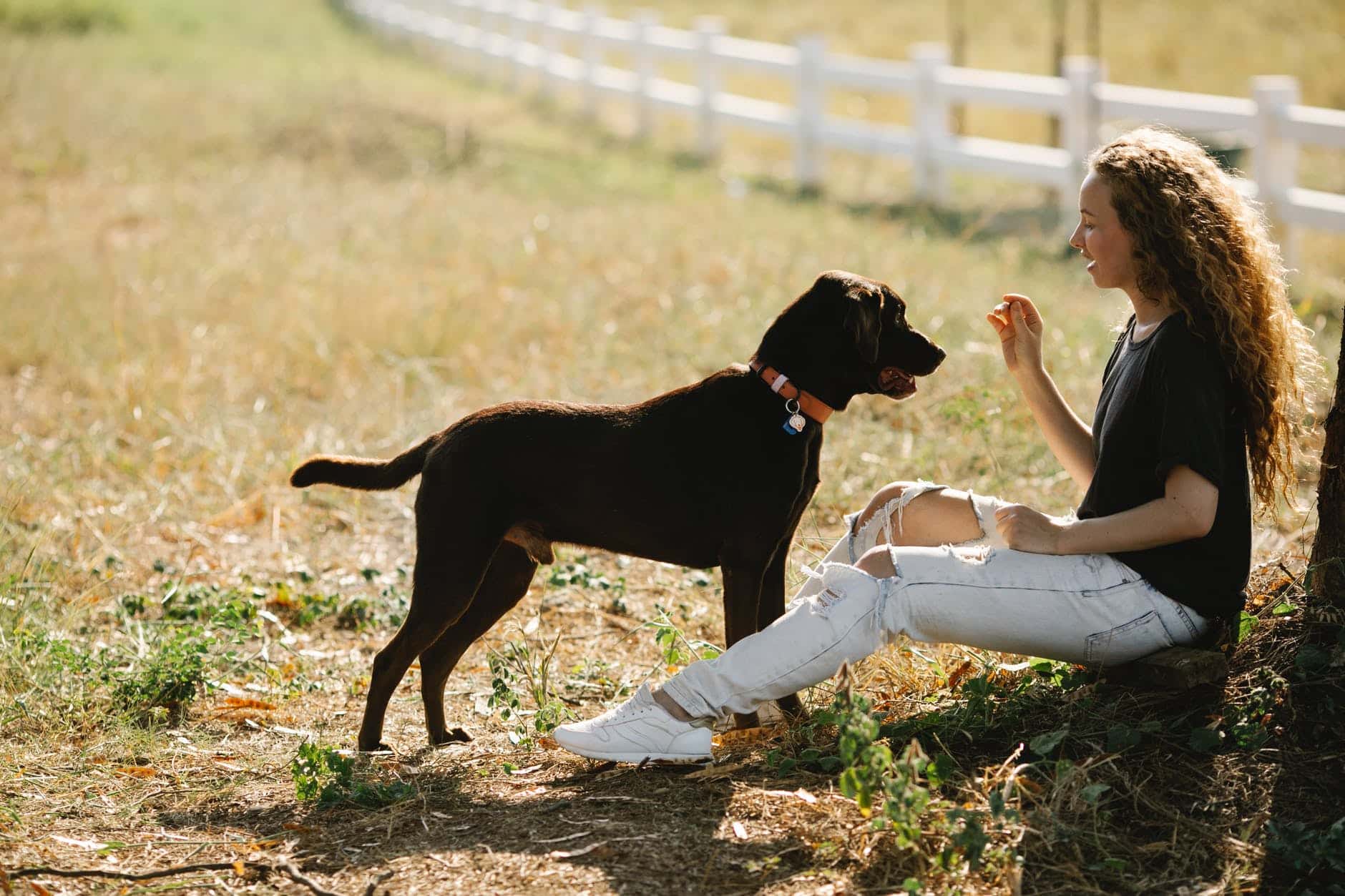
What is a Prong Collar?
A prong collar is a type of dog training collar that is made up of metal links with blunt prongs on either side. The prongs are designed to distribute pressure evenly around the dog’s neck so that when the dog pulls, pressure is applied. When they stop pulling, the pressure goes away.
Prong collars look scary because of their design, but when used correctly, they are a very safe, humane, and effective way to train your dog not to pull on the leash.
Contrary to popular belief, prong collars will not hurt your dog. The prongs are blunt and rounded; if they are sharp and pointy, you’ve bought a cheap knock-off dog training collar!
Prong collars were originally designed to protect the dog’s trachea by distributing pressure evenly. Flat buckle collars, slip collars, choke collars and martingale collars cannot offer this.
When a dog pulls into a regular buckle collar or anything like it, all of the pressure goes into the front of their neck and yes, their trachea!
This can be painful and damaging to the dog.
Many people believe that prong collars are much worse than Gentle Leaders, which is unfortunate and based on a lot of misguided marketing.
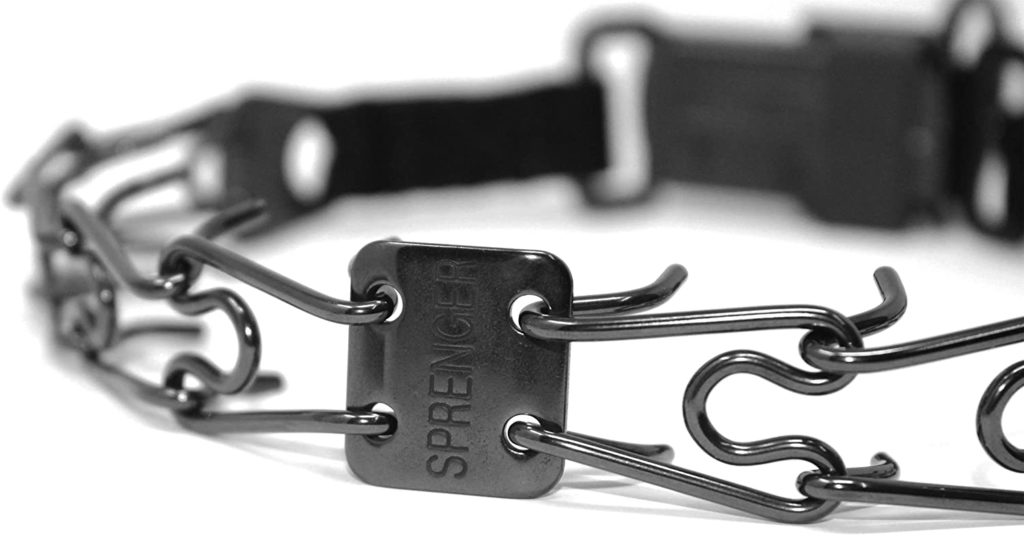
Are Prong Collars Abusive?
No, prong collars are not abusive.
They are a safe, effective and surprisingly gentle way to train your dog not to pull on the leash.
Many dogs that have been trained with prong collars live happy, healthy lives without any adverse effects.
For dogs that cannot be walked because of pulling, lunging and dragging their owners down the street, the prong collar is a game-changer. When used correctly, there is no negative body language.
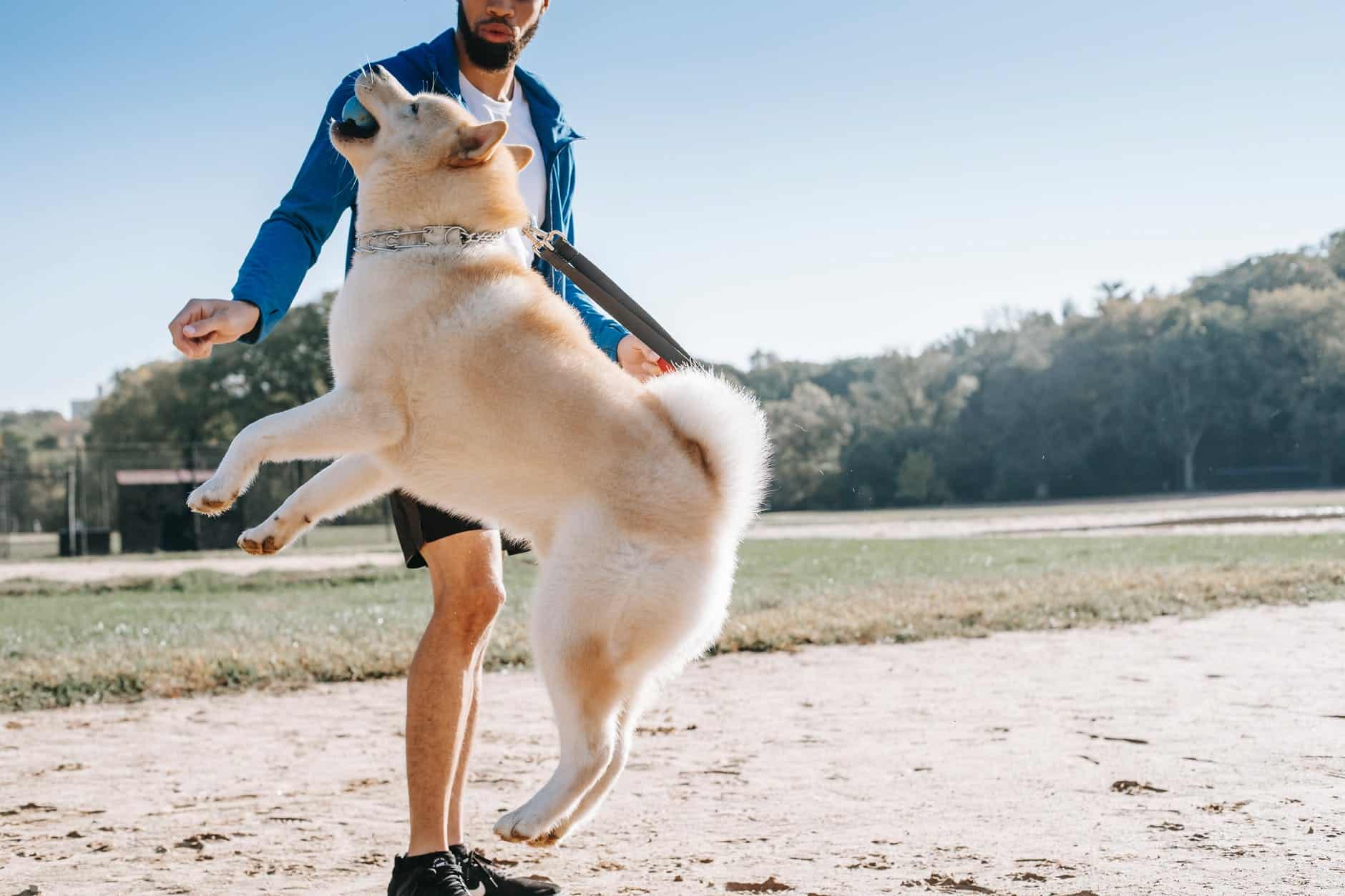
Prong collar vs. Gentle Leader story time!
I’m in an advanced training class with my large male Great Dane. In the class there are some dogs on flat collars, some dogs on prong collars, and some dogs on head halters.
The dog owners who chose Gentle Leaders for their dogs did so because they believed it was the more humane choice. Our trainer is a positive reinforcement balanced trainer who is fine with either option.
However, if you watch the dogs in this class, the negative and stressed body language we see is coming exclusively from the head halter dogs!
On the flip side, the prong collar dogs are happy, enthusiastic, comfortable, and engaged.
Despite 2 years of positive reinforcement training, the Gentle Leader dogs are still frustrated with the nylon webbing on their face. They show signs of stress including whale eye, pawing, shyness, rubbing, rolling and pinned ears.
If you use a prong collar correctly, it will not damage your dog or lead to ongoing frustration and annoyance with the tool being used. That’s a simple fact.
Tread cautiously with marketing that is designed to make you feel otherwise.
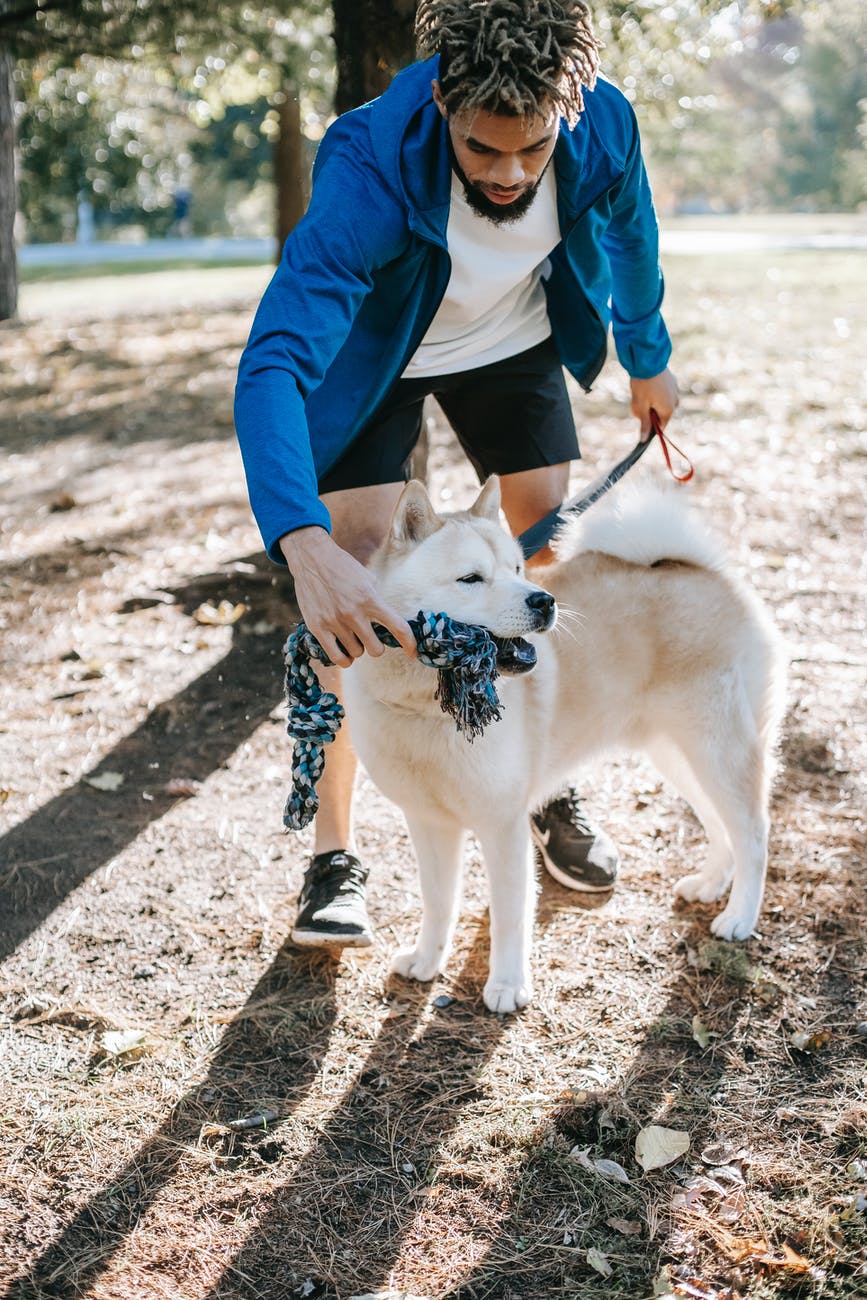
Are Prong Collars a Humane Tool?
Prong collars are a safe, effective and humane way to train your dog not to pull on the leash.
They are not cruel or abusive, and when used correctly, they will not damage your dog in any way.
In fact, correctly used, high-quality prong collars have been shown time and time again to be much more gentle, dog-friendly and humane than head halters (Gentle Leader)!
Remember, the prong collar works by distributing pressure evenly around the dogs neck.
They are not pinching the dogs skin or causing pain (unlike a regular collar which can damage the dogs trachea if they lunge or pull into it).
High quality prong collars (such as the Herm Sprenger, the brand we recommend) have a trachea plate on the front to further reduce the pressure a dog may put into the front of their throat when pulling.
We would rather see a dog out and about, properly trained in a prong collar, than a dog who has to stay home because they are too difficult to handle on a leash.
What is the difference between a pinch collar and a prong collar?
There is actually no difference between a pinch collar and a prong collar. They are two terms for the same thing.
The term ‘pinch collar’ came about because you have to ‘pinch’ two links together to close the collar around your dogs neck. The pinching of the link has nothing to do with pinching your dog’s neck.
People think that prong collars look like torture devices, so they took the ‘pinch’ collar word and ran with it.
Because the word ‘pinch collar’ evokes the concept of ‘pain’, people think it means that a prong collar is teaching dogs avoidance and fear.
The reality is that prong collars are just a tool, and dog trainers who use them are often very focused on ethics, positive training and helping dogs and owners live their best lives possible.
All dog training collars and tools available can be used humanely or inhumanely. This includes the prong collar, martingale collar, choke collar, e-collar, flat collar and yes, even harnesses.
It ultimately boils down to the individual using the collar or tool, not the tool itself, however. This is why, if you are willing to put the time into positive conditioning and addressing lunging or other dangerous behaviors as well, a Gentle Leader can be an acceptable choice for you.

Why Don’t ‘Positive’ Trainers like Prong Collars?
Positive trainers believe there is a war to wage against training tools that they have determined to be aversive and inhumane. This includes prong collars, which look scary.
Some tools by nature are more aversive than others. In our opinion, the head collar is naturally more aversive to dogs than a prong collar.
Because they don’t understand how a prong collar works or is used, they assume it’s a torture device and market it as such. This fanatic war against tools has even made it to politics, where lobbyists have successfully outlawed certain tools in some Countries by using poorly done ‘studies’ and inflammatory language.
When comparing the gentle leader vs. the prong collar, we believe there is so much more to it than the fact that the prong collar simply ‘appears’ harsher.
It doesn’t matter that the tools ‘positive’ trainers tend to recommend (no-pull harnesses and Gentle Leaders) have serious pitfalls and are far from ‘positive’. Some people have drawn an arbitrary, uneducated line in the sand.
We believe that the best kinds of dog training rely heavily on positive reinforcement AND the ethical, thoughtful use of the right tool for each dog being trained.
Run from any dog trainer who advocates for the ‘yank and crank’ method of prong collar or choke collar training, of course. That is not the correct use of any tool.
Alternatively, run from any dog trainer who tells you that ‘balanced’ training and properly used prong collars are abusive.



| Gentle Leader | Prong Collar |
|---|---|
| Aversive to wear, no matter the fit | Non-aversive to wear with correct fit |
| Requires conditioning for wearing & using | Requires training for using, not wearing |
| Looks ‘Gentle’ and seems positive | Looks scary and painful, but is misunderstood |
| Inexpensive | Spendy |
| Can damage nerves, eyes, neck, and spine when used normally | Can only cause damage to the skin if used abusively or incorrectly |
| May cause sores on the bridge of the nose | Does not cause skin sores or abrasions |
| People rarely judge this tool | People are often judgmental |
| May exacerbate underlying health problems | Unlikely to cause orthopedic damage |
| Dangerous for dogs with orthopedic issues, especially wobblers | An alternative choice for dogs who should not be pulling into a harness or collar for any reason |
| Negative body language is seen with normal ‘positive’ use | Negative body language is seen with harsh and incorrect use |
| Effective at reducing pulling | Effective at reducing pulling |
What is the Best Prong Collar?
The only prong collar brand we can confidently recommend at this time is Herm Sprenger.
The company has been around for over 100 years and has pioneered the design and use of prong collars. One of the key features of a proper prong collar is the round, blunt ends.
There should be no sharp points to poke or pinch your dog. We recommend choosing a model with the martingale loop, which will allow you to quickly apply and release pressure into the collar.
This pressure is a communication that your dog will understand.
Pulling in and of itself is dangerous, but isolation from experiences and life because of pulling behavior can be unfair and unethical, too. The prong collar has helped millions of dog owners bridge that gap.
How do I Train my Dog with a Prong Collar?
All good dog training starts with positive reinforcement.
We recommend starting your prong collar training in a low distraction environment, off-leash.
Have your dog wear the prong collar. It should fit snuggly and not rub or poke. Loose prong collars are dangerous and uncomfortable to wear. A properly fit one should feel no different to your dog than a flat collar.
While your dog is off-leash, use treats and praise to reward your dog for standing by your side, taking a step forward with you, and staying focused on you as you walk.
Ideally, your dog should have a basic understanding of ‘heel’ and ‘look’ or ‘focus’ before you add prong collar pressure to your training.
Once your dog has a great understanding of this, it’s time to teach your dog how to control the pressure from the prong collar.
Attach a sturdy leash to the prong collar and get started.
Allow your dog to sniff, noodle around, and walk away. Take a step backward and gently apply constant pressure to the collar through the leash. Do not snap, tug or pop the collar. Just apply a gentle, ongoing tug until your dog yields to the pressure.
Your dog will turn and start coming to you. The pressure will release naturally. As SOON as they do this, mark with a YES and then reward your dog and walk forward a few steps together.
This process teaches the dog how to ‘turn off’ the pressure from their prong collar. They are in control! Repeat this step as often as possible, over the course of several days.
Make a fun game of this where your dog is encouraged to stay near you and focused on you as you zig-zag and weave around obstacles.
Use lots of rewards and make sure that your dog is consistently able to respond to the pressure of their prong collar and release it themselves.
When comparing a prong vs. a Gentle Leader, the beautiful thing here is that a dog can turn off the pressure from a prong collar and has full control of it. They cannot turn off the pressure from a Gentle Leader, it will always be on their face, irritating the sensitive nerves whether they are pulling or not.
With these basic positive training exercises, your dog will become very confident in its understanding of the collar, what it means and how to turn the pressure off. You will notice positive body language and enthusiasm!
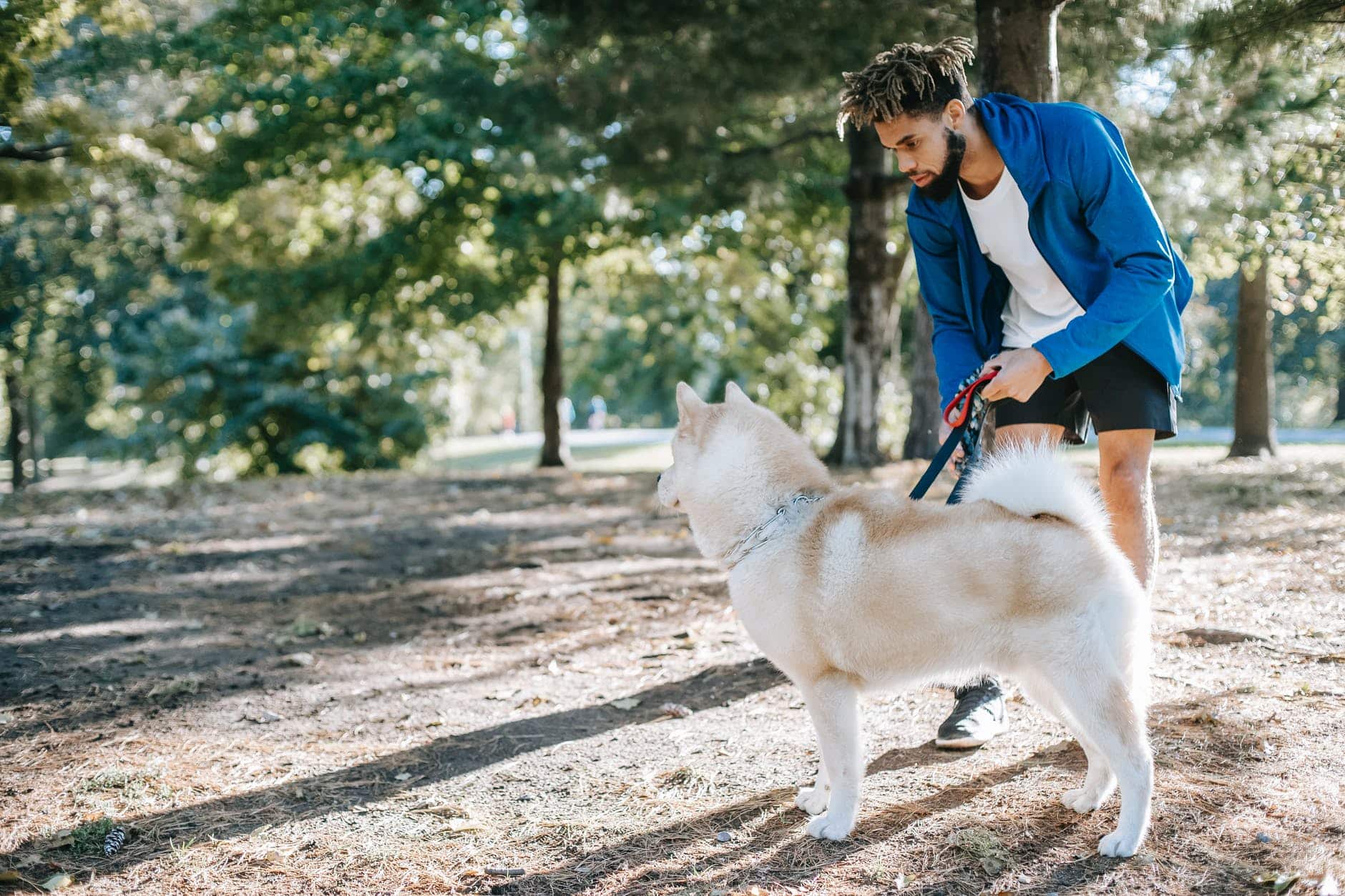
What is the Best Tool to Use on a Reactive Dog?
There are several types of reactivity.
Leash reactivity is common and is most often caused because dogs are nervous about the constant tension they feel from the leash. It prohibits them from moving naturally and they feel trapped. Reactivity builds and many dogs who are leash reactive are perfectly fine and friendly off-leash.
Fear-based reactivity is often the result of poor genetics and poor early socialization or experiences such as abuse. This kind of reactivity requires diligent monitoring and thoughtful attention to confidence-building and avoiding triggers.
General reactivity can be caused by the dogs preferences that you not mess with their food, pain or other medical issues. Always speak with your vet if your dog develops sudden reactivity.
Stress, anxiety, leash tension, unfair corrections and being ‘over threshold’ are contributing factors.
When it comes to choosing the right tool to use on a dog with reactivity, it’s important to keep in mind that good training starts by keeping the dog comfortable, and creating positive experiences around triggers.
For dogs that are extremely aggressive, a martingale collar is required. It is the only truly escape-proof option.
All training tools (including ‘no-pull harnesses’, Gentle Leaders, and Prong collars) can lead to increased frustration in reactive, fearful, and aggressive dogs if they are not implemented correctly.
We recommend working with a professional balanced positive reinforcement trainer to help you choose the best tool and training method for your dog, and show you how to help your dog have positive experiences that will build their confidence.
When used correctly, prong collars (AKA ‘pinch collars’) can be a very effective way to train and communicate to dogs with reactivity issues. But they should only be used under the guidance of a qualified trainer, on certain dogs who have already build on the basics of good obedience (sit, down, leave it, wait, place, stay, come).
Gentle Leaders are not recommended for use on reactive dogs or dogs that lunge, buck, or pull wildly as they risk damaging their neck, spine, eyes, and sensitive nerve endings.
Puppy Training: 5 Mistakes in Training
How to Stop a Great Dane from Jumping Up
How to Teach a Great Dane to Walk on Leash
Is the Gentle Leader an Abusive Tool?
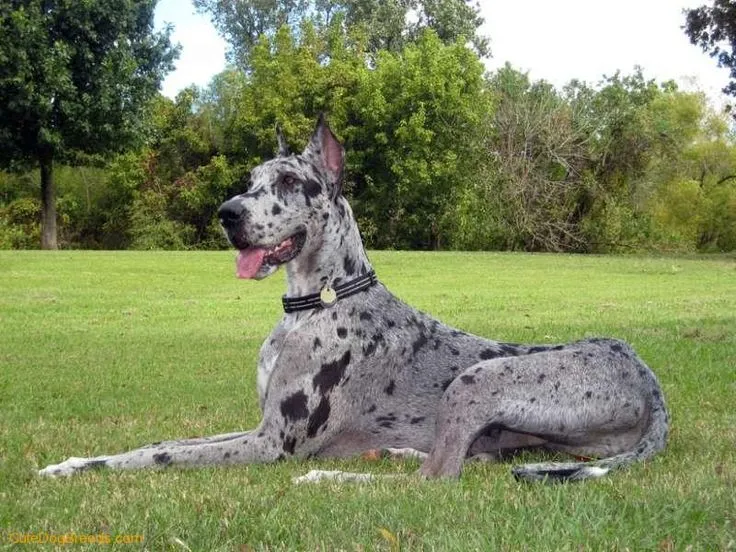
Final Verdict: Gentle Leader vs. Prong Collar
So which is better? The answer may surprise you.
While we strong advocate for the use of the prong collar as we believe that it the safest and most humane and effective choice, especially on large and giant breed dogs, the truth is that you should use the tool that works for you and your dog.
If your dog is showing positive body language and enjoying freedom, enrichment and safe walks because of the tool you chose, then you are doing the right thing!
Do not let ANYBODY make you feel bad for choosing a training tool, especially not a prong collar, if your dog is enjoying life as a result of the tool.
Get out in the world and stop isolating yourselves and your dog from life because they pull, lunge or cannot walk politely on a leash!
It’s time to make a humane, ethical choice and train your dog with the tool that works for you.



